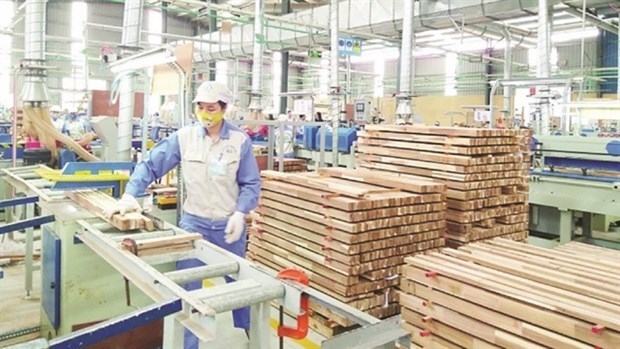
AsemconnectVietnam - Vietnam faces a tough balancing act between hitting its annual growth target and maintaining stability in its markets, its government and central bank said on Monday, as slowing global demand dims prospects in the regional manufacturing hub.
Declining exports, rising inventory levels, inflation and slow foreign direct investment are among the challenges the country is facing, the planning and investment ministry said, as it forecast GDP growth at 6.0% to 6.5% for the year.
"The adverse global conditions have affected domestic growth and business activities, especially industrial production and exports," the ministry said in a statement, adding the difficulties may last until the end of the second quarter.
Vietnam reported growth of
3.32% in the first quarter of the year, slowing from 5.92% in the fourth quarter of 2022.
Exports dropped 11.9% from a year earlier, notably of seafood, which fell by a third, while orders for its garment products fell 15% to 20%.
The central bank on Monday said it was facing significant pressure to support growth while keeping the banking system and foreign exchange markets stable, after having
cut its refinance rate by 50 basis points for the second time in two weeks.
The State Bank of Vietnam also said it bought $4 billion worth of U.S. dollars from the market in the first quarter, in a move it described as "pumping (the dong currency) to the system to have abundant liquidity".
Capital Economics said it expected the central bank to cut rates even further given the weakness of recent data.
"With global growth set to remain weak in the coming quarters, we think Vietnam's economy will remain under pressure," it said, adding it expected GDP growth to slow to 5.0% in 2023 from 8.0% in 2022.
Vietnam's manufacturing PMI falls back into contraction in March
Vietnam's manufacturing sector slipped back into contraction in March as new orders continued to fall, according to a report released by S&P Global Market Intelligence on Monday.
The S&P Global Vietnam Manufacturing Purchasing Managers' Index (PMI) dipped to 47.7 in March from last month's reading at 51.2, falling back below the 50-point level separating expansion from contraction.
Overall new orders were down for the fourth time in the past five months due to "relatively subdued demand", while new business from overseas markets dipped for the first time in three months.
The decline in new work led to falls in manufacturing output and staffing levels, said the report.
Amid signs of inflation pressures easing at the end of the first quarter, raw material prices rose at the slowest pace since last October, making companies increase their charges at the softest pace in a third straight month of rises, the report found.
However, the renewed falls in March will hopefully be just a temporary problem as firms remain confident about demand improvements and stable market conditions in the year ahead with some even pointing to business expansion plans, according to Andrew Harker, Economics Director at S&P Global Market Intelligence.
S&P Global Market Intelligence is forecasting a rise in Vietnam's industrial production of 6.6 percent in 2023.
The PMI index measures the activity level of purchasing managers in the manufacturing sector. A reading above 50 indicates expansion on a monthly basis in the sector, and a reading below implies contraction.
Vietnam c.bank cuts refinance rate by 50 bps to support growth
Vietnam's central bank said on Friday it will cut its refinance rate by 50 basis points effective April 3, bucking the regional trend as it maintains its focus on supporting economic growth amid global uncertainty.
The move brings the refinance rate to 5.5%, while the discount rate will remain unchanged at 3.5%, the State Bank of Vietnam (SBV) said.
It follows the central bank's surprise decision earlier this month to cut several policy rates - its first policy easing since late 2020 after a series of interest rate increases.
"In order to extricate the obstacles for the economy, businesses and citizens, the SBV decided a further cut on the policy rate," it said in a statement late on Friday.
Vietnam's economic growth
slowed to 3.32% in the first quarter from 5.92% in the fourth quarter of 2022.
The decision reflected an uncertain global outlook, with inflation in several countries high and Vietnam's economic growth lower than had been anticipated, the SBV said, adding that domestic inflation was under control.
Vietnam Q1 GDP growth slows as weak demand hits exports
Vietnam's economic growth slowed to 3.32% in the first quarter, against a 5.92% year-on-year expansion in the fourth quarter of 2022, government data showed on Wednesday, as exports of smartphones and electronics fell sharply.
The Southeast Asian country, a regional manufacturing hub, reported an 11.9% fall in overall exports in the January-March period from a year earlier due to weakening global demand.
Shipments of smartphones, the country's largest export earner, fell 15% to $13 billion in the first quarter from a year ago, while electronics shipments fell 10.9%, the GSO said. Industrial production in the first quarter fell 2.3% from a year earlier, while retail sales of goods and services rose 13.9%, the GSO said.
Consumer prices in March fell 0.23% from February, the GSO said. Average consumer prices in the first quarter rose 4.18% from a year earlier.
Vietnam is targeting 6.5% growth of gross domestic product this year, below a decade-high expansion of 8.02% last year.
The country's central bank earlier this month cut several policy rates to increase liquidity and support economic growth, in a surprise move that set it apart from regional peers amid the global financial turmoil.
Vietnam's benchmark stock index
(.VNI) has lost 29% over the past year, according to Refinitiv data.
T.Huong
Source: Vitic/Reuters






